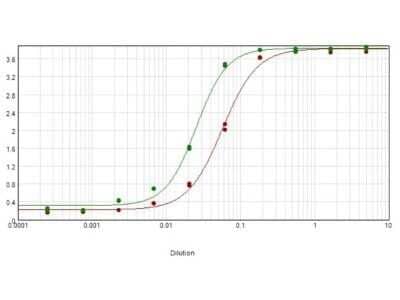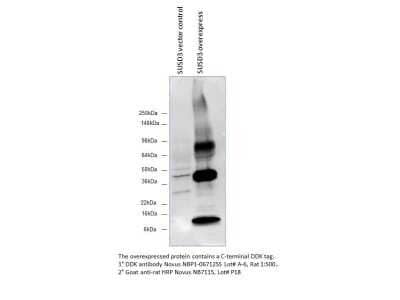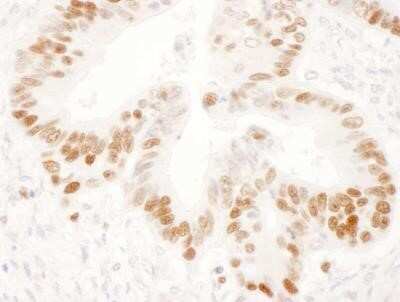IgG (H+L) Products
Antibodies, also known as immunoglobulins (Igs) are critical for immunity and are grouped into five primary classes: IgG, IgM, IgA, IgD, and IgE. The most abundant antibody isotype is immunoglobulin G (IgG) with concentrations ranging from 7.5-22 mg/ml in human serum and has a molecular weight of 150 kDa. The major effector functions of IgG include...
Show More
1844 results for "IgG (H+L)" in Products
1844 results for "IgG (H+L)" in Products
IgG (H+L) Products
Antibodies, also known as immunoglobulins (Igs) are critical for immunity and are grouped into five primary classes: IgG, IgM, IgA, IgD, and IgE. The most abundant antibody isotype is immunoglobulin G (IgG) with concentrations ranging from 7.5-22 mg/ml in human serum and has a molecular weight of 150 kDa. The major effector functions of IgG include...
Show More
| Reactivity: | Mouse |
| Details: | Rabbit IgG Polyclonal |
| Applications: | IHC, WB, ELISA |
Applications: IHC, WB, ELISA, ICC/IF
| Reactivity: | Rabbit |
| Details: | Goat IgG Polyclonal |
| Applications: | IHC, WB, ELISA, ICC/IF |
Applications: IHC, WB, ELISA, ICC/IF, Flow
| Reactivity: | Mouse |
| Details: | Goat IgG Polyclonal |
| Applications: | IHC, WB, ELISA, ICC/IF, Flow |
Applications: IHC, WB, ELISA, ICC/IF
| Reactivity: | Mouse |
| Details: | Goat IgG Polyclonal |
| Applications: | IHC, WB, ELISA, ICC/IF |
Applications: IHC, WB, ELISA, ICC/IF, Flow
| Reactivity: | Rabbit |
| Details: | Goat IgG Polyclonal |
| Applications: | IHC, WB, ELISA, ICC/IF, Flow |
| Reactivity: | Llama, Alpaca |
| Details: | Goat IgG Polyclonal |
| Applications: | IHC, WB, ELISA, ICC/IF |
| Reactivity: | Llama |
| Details: | Goat IgG Polyclonal |
| Applications: | IHC, WB, ELISA, ICC/IF |
Applications: IHC, WB, ELISA, ICC/IF, PAGE
| Reactivity: | Rabbit |
| Details: | Goat IgG Polyclonal |
| Applications: | IHC, WB, ELISA, ICC/IF, PAGE |
Applications: IHC, WB, ELISA, IP, Func
| Reactivity: | Rabbit |
| Details: | Goat IgG Polyclonal |
| Applications: | IHC, WB, ELISA, IP, Func |
Applications: IHC, WB, ELISA, ICC/IF
| Reactivity: | Goat |
| Details: | Rabbit Polyclonal |
| Applications: | IHC, WB, ELISA, ICC/IF |
| Reactivity: | Rabbit |
| Details: | Goat IgG Polyclonal |
| Applications: | IHC, WB, ELISA |
| Reactivity: | Mouse |
| Details: | Goat IgG Polyclonal |
| Applications: | IHC, WB, ELISA, IP, Func |
| Reactivity: | Mouse |
| Details: | Goat IgG Polyclonal |
| Applications: | IHC, WB, ELISA |
| Reactivity: | Rabbit |
| Details: | Guinea Pig IgG Polyclonal |
| Applications: | IHC, WB, ELISA |
Applications: IHC, WB, ELISA, ICC/IF, Flow
| Reactivity: | Bat |
| Details: | Goat IgG Polyclonal |
| Applications: | IHC, WB, ELISA, ICC/IF, Flow |
Applications: WB, ELISA
Reactivity:
Human
| Reactivity: | Human |
| Details: | Mouse IgG1 Monoclonal Clone #4D2D9G8 |
| Applications: | WB, ELISA |
| Reactivity: | Mouse |
| Details: | Goat IgG Polyclonal |
| Applications: | IHC, ICC/IF, Flow |
| Reactivity: | Goat |
| Details: | Donkey IgG Polyclonal |
| Applications: | IHC, WB, ELISA, ICC/IF |
Applications: IHC, WB, ELISA, ICC/IF
| Reactivity: | Rat |
| Details: | Goat IgG Polyclonal |
| Applications: | IHC, WB, ELISA, ICC/IF |
| Reactivity: | Goat |
| Details: | Chicken IgG Polyclonal |
| Applications: | IHC, WB, ELISA, ICC/IF, Flow |
Applications: IHC, WB, ELISA, ICC/IF, DB
| Reactivity: | Mouse |
| Details: | Rabbit Polyclonal |
| Applications: | IHC, WB, ELISA, ICC/IF, DB |
| Reactivity: | Canine |
| Details: | Goat IgG Polyclonal |
| Applications: | IHC, WB, ELISA, ICC/IF |
Applications: IHC, WB, ELISA, ICC/IF, Flow, Func, IP
| Reactivity: | Rabbit |
| Details: | Donkey IgG Polyclonal |
| Applications: | IHC, WB, ELISA, ICC/IF, Flow, +2 More |
Applications: IHC, WB, ELISA, ICC/IF, Simple Western
| Reactivity: | Mouse |
| Details: | Goat IgG Polyclonal |
| Applications: | IHC, WB, ELISA, ICC/IF, Simple Western |
Applications: IHC, WB, ELISA, ICC/IF, Flow
| Reactivity: | Goat |
| Details: | Donkey IgG Polyclonal |
| Applications: | IHC, WB, ELISA, ICC/IF, Flow |



![Western Blot: Goat anti-Mouse IgG (H+L) Secondary Antibody [NB7535] Western Blot: Goat anti-Mouse IgG (H+L) Secondary Antibody [NB7535]](https://resources.bio-techne.com/images/products/Goat-anti-Mouse-IgG-H+L-Secondary-Antibody-Western-Blot-NB7535-img0010.jpg)

![Flow Cytometry: Goat anti-Rabbit IgG (H+L) Secondary Antibody [NB7156] Flow Cytometry: Goat anti-Rabbit IgG (H+L) Secondary Antibody [NB7156]](https://resources.bio-techne.com/images/products/Goat-anti-Rabbit-IgG-H+L-Secondary-Antibody-Flow-Cytometry-NB7156-img0001.jpg)

![Western Blot: Goat anti-Rabbit IgG (H+L) Secondary Antibody (Pre-adsorbed) [NBP1-72732] Western Blot: Goat anti-Rabbit IgG (H+L) Secondary Antibody (Pre-adsorbed) [NBP1-72732]](https://resources.bio-techne.com/images/products/Goat-anti-Rabbit-IgG-H+L-Secondary-Antibody-Pre-adsorbed-Western-Blot-NBP1-72732-img0021.jpg)
![Western Blot: Goat anti-Rabbit IgG (H+L) Secondary Antibody [NBP1-75293] Western Blot: Goat anti-Rabbit IgG (H+L) Secondary Antibody [NBP1-75293]](https://resources.bio-techne.com/images/products/Goat-anti-Rabbit-IgG-H+L-Secondary-Antibody-Western-Blot-NBP1-75293-img0007.jpg)

![Western Blot: Guinea Pig anti-Rabbit IgG (H+L) Secondary Antibody (Pre-adsorbed) [NBP1-72763] Western Blot: Guinea Pig anti-Rabbit IgG (H+L) Secondary Antibody (Pre-adsorbed) [NBP1-72763]](https://resources.bio-techne.com/images/products/Guinea-Pig-anti-Rabbit-IgG-H+L-Secondary-Antibody-Pre-adsorbed-Western-Blot-NBP1-72763-img0009.jpg)
![Flow Cytometry: Goat anti-Bat IgG (H+L) Secondary Antibody [NB7237] Flow Cytometry: Goat anti-Bat IgG (H+L) Secondary Antibody [NB7237]](https://resources.bio-techne.com/images/products/Goat-anti-Bat-IgG-H+L-Secondary-Antibody-Flow-Cytometry-NB7237-img0002.jpg)
![Western Blot: Mouse anti-Human IgG (H+L) Secondary Antibody (4D2D9G8) [NBP1-51523] Western Blot: Mouse anti-Human IgG (H+L) Secondary Antibody (4D2D9G8) [NBP1-51523]](https://resources.bio-techne.com/images/products/Human-IgG-Antibody-4D2D9G8-Western-Blot-NBP1-51523-img0002.jpg)




![Western Blot: Donkey anti-Rabbit IgG (H+L) Secondary Antibody (Pre-adsorbed) [NBP1-75286] Western Blot: Donkey anti-Rabbit IgG (H+L) Secondary Antibody (Pre-adsorbed) [NBP1-75286]](https://resources.bio-techne.com/images/products/Donkey-anti-Rabbit-IgG-H+L-Secondary-Antibody-Pre-adsorbed-Western-Blot-NBP1-75286-img0009.jpg)
![Western Blot: Donkey anti-Goat IgG (H+L) Secondary Antibody (Pre-adsorbed) [NBP2-60657] Western Blot: Donkey anti-Goat IgG (H+L) Secondary Antibody (Pre-adsorbed) [NBP2-60657]](https://resources.bio-techne.com/images/products/Donkey-anti-Goat-IgG-H+L-Secondary-Antibody-Pre-adsorbed-Western-Blot-NBP2-60657-img0012.jpg)